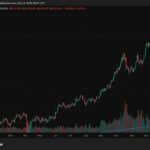
(Mr. Gann comes to us via
New Stock Trend Detector
A review of the 1929-1932 panic and the 1932-1935 bull market
Published in 1935
by William D. Gann -AM)
Anonymous Monetarist :Mr. Gann thank you for resurrecting yourself for this conversation. You were a finance trader who developed the technical analysis tool known as Gann angles. How would you summarize your philosophy?
'Thanks nice to be here. Well I would summarize my philosophy as suggesting future stock movements can be forecast by a study of past history and past movements. By knowing the time when the greatest advances have taken place and the times when the greatest panics and declines have occurred and the time periods to watch for major and minor changes in trend, you can detect what to expect in the future. Advances and bull markets will come in the future and panics will come in the future, just as they have in the past. It is important to study the time that has elapsed between bottoms and tops and the greatest duration of any bull campaign as well as the greatest duration of any panic or decline.'
What have your studies determined?
'The culmination of the bull market in September 1929 was really the result of a long trend business cycle which began in August, 1896 and continued for 33 years, with each campaign in the market making higher prices, which showed that the long-term trend was up. The Bryn Silver Panic August 1896 low of the Dow-Jones Averages at 29 was the end of a panicky decline that marked the beginning of the McKinley boom which lasted several years'
'The lows in this uptrend were:April 1897 at 40 and one half; October&November of 1903 at 42 and one half; Nov 1907 and June 1913 which both saw 53; December 1914 touched 53 and a half; and then December 1917 and 1920 which both bottomed at 66.'
'The August 1921 low of 64 was still a good sign of support in this uptrend, for it did not violate previous lows by 3 points, roughly 5%, thus indicating that a bull market would follow. From this August low followed the greatest bull market in the history of the United States, culminating at 386 in September 1929.'
Greater than 1992-2000?
'Yes, actually your recent run from 1982 to 2000 was a bit larger in price gain than 1896-1929..and of course in less than half the time. However the 8 year bull in the 20s that ended on September 3, 1929 increased price by a factor of 6 while your 8 year run from 1992 to 2000 increased prices less than 4 times.On September 3, 1929 when the final top was reached the Industrial Averages made 386 which was approximately 13 times higher in price than the Bryn Silver Panic Low.' '
'After the greatest bull market in history, the greatest bear market in history must follow... my philosophy is that one must look back in order to determine how long the bear campaign might run. Going back over all the records, we find that the greatest bear market had lasted not more than 43 months and the smallest had been as short as 12 months. Some of them had culminated around 27 months,30 months,34 months and in extreme declines,anywhere from 36 to 43 months. You handed me cue cards describing the research since the Great Depression but I can't read your writing...'
13 recessions since 1929 lasted on average 10 months. The longest,the Great Depression, lasted 44 months. The third longest(1973-1975, 1981-1982) each lasted 16 months, and we're in the second longest and counting. How would you then compare our outcome given yours?
'On July 8, 1932, the Dow Jones Averages made a low at 40 and 1/5. This was equal to the April 1897 low and was successfully tested. Several bear market lows were tested and broken on that campaign. In fact we can track a general uptrend of higher lows from this April 1897 and July 1932 low up through the May 2000 highs. This current bear market campaign with highs in March of 2000 and May of 2007 (2007 higher closing but lower intraday) has broken past support similar to our crash in 1929 and subsequent rally. The key will be to see what support holds. So far, the 2002 S&P 500 low of 768 obviously did not hold.'
Thank you William.




No comments:
Post a Comment